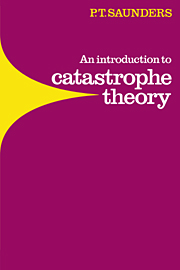Book contents
- Frontmatter
- Contents
- Preface
- 1 Introduction
- 2 Background
- 3 The seven elementary catastrophes
- 4 The geometry of the seven elementary catastrophes
- 5 Applications in physics
- 6 Applications in the social sciences
- 7 Applications in biology
- 8 Morphogenesis
- 9 Conclusions
- Exercises
- Appendix. Elementary catastrophes of codimension ≦ 5
- References
- Author index
- Subject index
3 - The seven elementary catastrophes
Published online by Cambridge University Press: 05 June 2012
- Frontmatter
- Contents
- Preface
- 1 Introduction
- 2 Background
- 3 The seven elementary catastrophes
- 4 The geometry of the seven elementary catastrophes
- 5 Applications in physics
- 6 Applications in the social sciences
- 7 Applications in biology
- 8 Morphogenesis
- 9 Conclusions
- Exercises
- Appendix. Elementary catastrophes of codimension ≦ 5
- References
- Author index
- Subject index
Summary
In this chapter we derive Thorn's famous list of seven elementary catastrophes. We have already seen that we need only consider Taylor series in one or two variables; we now have to find all the different cases which can arise with codimension no greater than 4.
We begin with some mathematical preliminaries. First, we have to be clear about what we mean by ‘different’ cases. The usual statement is that there are seven qualitatively different catastrophes, and when we come to discuss the applications of the theory it will be clear enough what this means. But we need a more precise definition if we are to know what sorts of mathematical operations we may use in the derivations, so we say that two catastrophes are equivalent if one can be transformed to the other by (i) a diffeomorphism of the control variables, and (ii) at each point in the control space a diffeomorphism of the state variables. The resulting family of state-variable diffeomorphisms must be smooth when considered as a function of the control variables.
A diffeomorphism is a one-to-one continuous differentiable transformation. It is sometimes useful (though not strictly accurate) to think of two geometric objects as being topologically equivalent, or homeomorphic, if one can be continuously deformed into the other without any tearing or pasting together. To the same degree of accuracy we may think of two geometric objects as being diffeomorphic if they are homeomorphic and if, in addition, the deformation involved no creasing or flattening of creases.
Information
- Type
- Chapter
- Information
- An Introduction to Catastrophe Theory , pp. 30 - 40Publisher: Cambridge University PressPrint publication year: 1980
